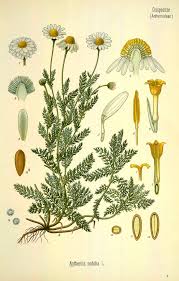The type of chamomile most often used in aromatherapy is called Roman chamomile (Anthemis noblis), which is also known as Chamaemelum nobile, or 'noble chamomile'. The oil's colour varies from clear to very pale blue. German chamomile (Matricaria recutica) is the other type used in aromatherapy, which has a rich, dark blue to green colour and is thicker in consistency.

Although the two types of chamomile have different benefits, both contain an effective anti-inflammatory, called azulene, although German chamomile contains a greater amount.
Gentle for Children
The uses of chamomile and lavender can seem to overlap. Both essential oils are soothing and calming, and could be used together for an even greater effect. Use chamomile whenever there is inflammation, and lavender more for when anti-infectious action is needed.
Like lavender, chamomile is a suitable oil for children. It can even be used for teething infants, if it is diluted in carrier oil and smoothed into the affected area. Whether you make your own herbal tea from dried chamomile flowers or use a teabag, a little weak tea can be sipped by a child or added to the bath. Both as an essential oil and as a tea, chamomile will soothe nervousness and encourage a fretful child to sleep.
Smelling of Apples
The healing properties of chamomile have been highly valued for more than 4,000 years. In ancient Egypt, chamomile was considered sacred, and dedicated to the sun god Ra, and as the religious rituals were performed at dawn, so the tiny chamomile flower opened its petals. The word chamomile comes from the Greek word khamaimelon, meaning earth apple, because Roman chamomile has the aroma of over-ripe apples. The ancient Arabic doctors used chamomile, as did the Saxons, and all surviving ancient European herbals mention it. In Victorian times chamomile, along with lavender, was used to calm people who became hysterical.
The flowers have for centuries been used to scent clothing and bed linen, made into potpourries, strewn on floors to deter fleas and other insects, and used to freshen the air. Light-haired women would put chamomile flowers in the final rinsing water to brighten and perfume their hair.
Famous Tea

Chamomile flowers are easily brewed into a tea which is relaxing, healing and calming, particularly before going to bed. Drink chamomile tea to help soothe indigestion, nausea and gastritis, too. Legend has it that 150 years ago an English general poured chamomile tea over the gaping wound of his opponent.
The healing that took place was so impressive that he made a friend and peace was declared.
The 'Fake' Chamomile
An essential oil often sold as chamomile is actually a fake. Chamomile maroc is give the name chamomile because the daisy-like flower looks similar to true chamomile, but it has different properties. More accurately called 'Ormenis flower', it is used in colognes and perfumes. It does not contain azulene but it has certain healing properties, being helpful for insomnia, arthritis, rheumatism, colds and chills, and in skincare preparations. This oil is generally calming and eases emotional upsets, anxiety, fear, apprehension, worry, stress and tension - including the tension caused by a menopause-induced hormonal imbalance. It's also useful for those who are tired following over-activity.